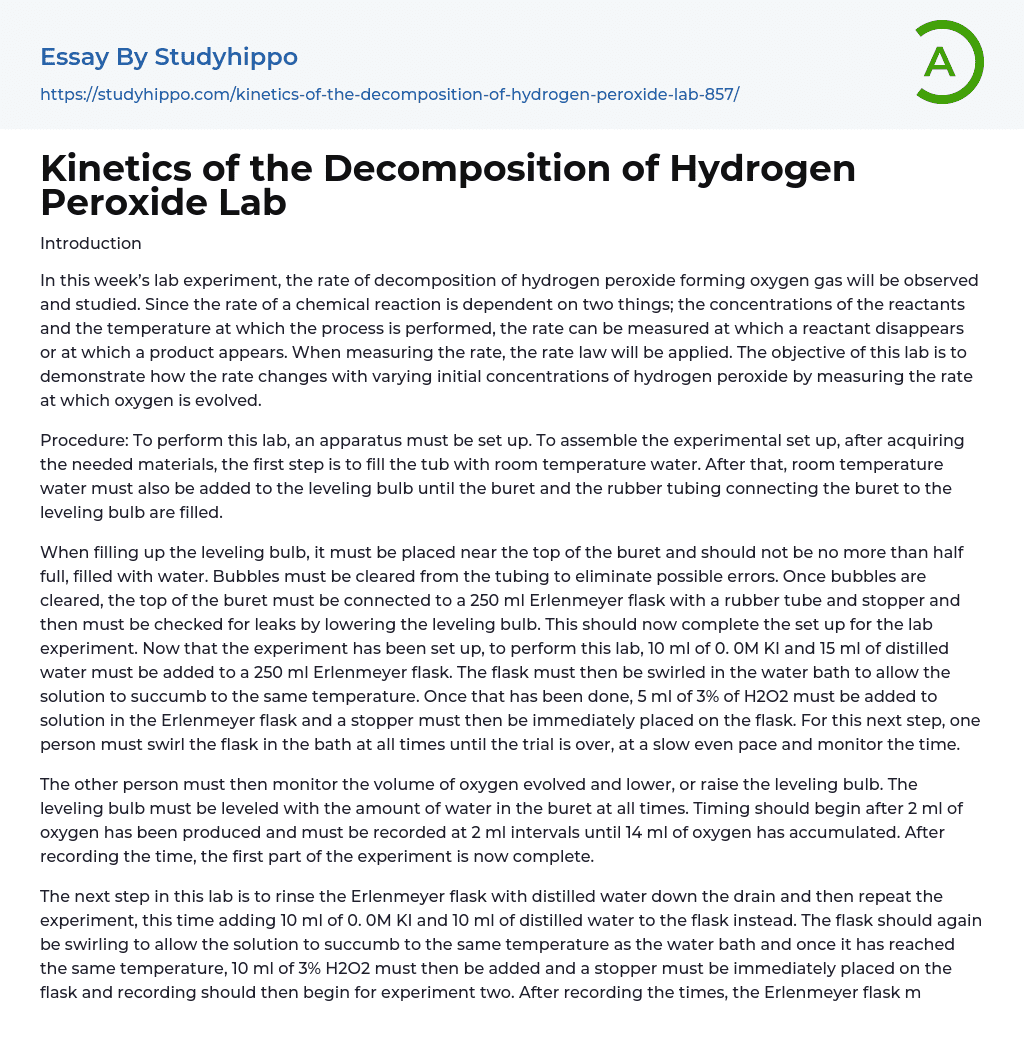

Kinetics of the Decomposition of Hydrogen Peroxide Lab Essay Example
Introduction
In this week’s lab experiment, the rate of decomposition of hydrogen peroxide forming oxygen gas will be observed and studied. Since the rate of a chemical reaction is dependent on two things; the concentrations of the reactants and the temperature at which the process is performed, the rate can be measured at which a reactant disappears or at which a product appears. When measuring the rate, the rate law will be applied. The objective of this lab is to demonstrate how the rate changes with varying initial concentrations of hydrogen peroxide by measuring the rate at which oxygen is evolved.
Procedure: To perform this lab, an apparatus must be set up. To assemble the experimental set up, after acquiring the needed materials, the first step is to fill th
...e tub with room temperature water. After that, room temperature water must also be added to the leveling bulb until the buret and the rubber tubing connecting the buret to the leveling bulb are filled.
When filling up the leveling bulb, it must be placed near the top of the buret and should not be no more than half full, filled with water. Bubbles must be cleared from the tubing to eliminate possible errors. Once bubbles are cleared, the top of the buret must be connected to a 250 ml Erlenmeyer flask with a rubber tube and stopper and then must be checked for leaks by lowering the leveling bulb. This should now complete the set up for the lab experiment. Now that the experiment has been set up, to perform this lab, 10 ml of 0. 0M KI and 15 ml of distilled water must be added t
a 250 ml Erlenmeyer flask. The flask must then be swirled in the water bath to allow the solution to succumb to the same temperature. Once that has been done, 5 ml of 3% of H2O2 must be added to solution in the Erlenmeyer flask and a stopper must then be immediately placed on the flask. For this next step, one person must swirl the flask in the bath at all times until the trial is over, at a slow even pace and monitor the time.
The other person must then monitor the volume of oxygen evolved and lower, or raise the leveling bulb. The leveling bulb must be leveled with the amount of water in the buret at all times. Timing should begin after 2 ml of oxygen has been produced and must be recorded at 2 ml intervals until 14 ml of oxygen has accumulated. After recording the time, the first part of the experiment is now complete.
The next step in this lab is to rinse the Erlenmeyer flask with distilled water down the drain and then repeat the experiment, this time adding 10 ml of 0. 0M KI and 10 ml of distilled water to the flask instead. The flask should again be swirling to allow the solution to succumb to the same temperature as the water bath and once it has reached the same temperature, 10 ml of 3% H2O2 must then be added and a stopper must be immediately placed on the flask and recording should then begin for experiment two. After recording the times, the Erlenmeyer flask must then be rinsed again with distilled water down the drain. After rinsing
the flask, the last part of the lab can now be performed.
Experiment three is performed the same way, but instead, 20 ml of 0. 10 ml M KI and 5 ml of distilled water will be added and after the swirling of the flask, 5 ml of 3% H2O2 will be added. After the times have been recorded, data collection should now be complete.
- Bottled Water essays
- Acid essays
- Calcium essays
- Carbohydrate essays
- Carbon essays
- Chemical Bond essays
- Chemical Reaction essays
- Chemical reactions essays
- Chromatography essays
- Concentration essays
- Copper essays
- Diffusion essays
- Ethanol essays
- Hydrogen essays
- Organic Chemistry essays
- Osmosis essays
- Periodic Table essays
- Ph essays
- Salt essays
- Sodium essays
- Titration essays
- John Locke essays
- 9/11 essays
- A Good Teacher essays
- A Healthy Diet essays
- A Modest Proposal essays
- A&P essays
- Academic Achievement essays
- Achievement essays
- Achieving goals essays
- Admission essays
- Advantages And Disadvantages Of Internet essays
- Alcoholic drinks essays
- Ammonia essays
- Analytical essays
- Ancient Olympic Games essays
- APA essays
- Arabian Peninsula essays
- Argument essays
- Argumentative essays
- Art essays
- Atlantic Ocean essays
- Auto-ethnography essays
- Autobiography essays
- Ballad essays
- Batman essays
- Binge Eating essays
- Black Power Movement essays
- Blogger essays
- Body Mass Index essays



